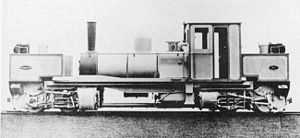TGR K class
| TGR K Class | |
|---|---|
|
Works photograph of K1 | |
| Type and origin | |
| Power type | Steam |
| Builder | Beyer Peacock |
| Serial number | 5292 |
| Build date | 1909 |
| Total produced | 2 |
| Specifications | |
| Configuration | 0-4-0+0-4-0T |
| Gauge | 2 ft (610 mm) |
| Driver diameter | 2 ft 7 1⁄2 in (800 mm)[ref 1] |
| Wheelbase |
26 ft 9 in (8,153 mm) overall 4 ft (1,219 mm) each power unit[ref 1] |
| Length | 32 ft 2 in (9,800 mm)[ref 1] |
| Locomotive weight | 33.5 long tons (34.0 t; 37.5 short tons)[ref 1] |
| Fuel type | Coal or Oil |
| Tender capacity | 840 imp gal (3,800 l; 1,010 US gal)[ref 1] |
| Boiler pressure | 195 psi (13.4 bar; 1,340 kPa)[ref 1] |
| Firegrate area | 14.8 sq ft (1.37 m2)[ref 1] |
| Heating surface: – Tubes | 568 sq ft (52.8 m2)[ref 1] |
| – Firebox | 60 sq ft (5.6 m2)[ref 1] |
| – Total | 628 sq ft (58.3 m2)[ref 1] |
| High-pressure cylinder size |
11 in × 16 in (280 mm × 410 mm) diameter × stroke[ref 1] |
| Low-pressure cylinder size |
17 in × 16 in (430 mm × 410 mm) diameter × stroke[ref 1] |
| Valve gear | Walschaerts |
| Performance figures | |
| Tractive effort | 16,290 lbf (72.46 kN)[ref 1] |
| Career | |
| Operator(s) | WHR |
| Number in class | 1 |
| Number(s) | K1 |
| Disposition | In service |
The Tasmanian Government Railways (TGR) K Class was a class of steam locomotive. The class numbered two locomotives, K1 and K2 built in 1909.[ref 2] They were 0-4-0+0-4-0 Garratts and the first Garratt locomotives ever produced.[ref 2] K1 survives at the Welsh Highland Railway in Wales.
Overview


Although considered the first Garratt locomotives, they did in fact differ in two important details from Herbert Garratt's original concept. First: they are compound locomotives, with two high pressure cylinders on the rear engine, and a pipe leading to two larger low pressure cylinders on the front engine; second: both sets of cylinders were placed facing each other inside their engine units, rather than facing out as in all other Garratts. This was a problem on the rare warm days on the West Coast Range in Tasmania, as one pair of cylinders was under the cab, making the cab uncomfortably hot.[ref 2]
The North East Dundas Tramway on which they worked traversed some of the most rugged terrain in the world served by a railway at the time. It featured long stretches of 1 in 25 grades, high trestle bridges and 30 metre radius reverse curves. [1] The K class joined three other classes of locomotive working on the line: the tiny H class Krauss 0-4-0WT with a tractive effort of 1,740 lbs, the G class Sharp Stewart 0-4-2T with 7,680 lbs and a single J Class 2-6-4-0 articulated Hagans locomotive which, with a tractive effort of 19,349 lbs, was more powerful than the Garratts.
After the line closed in 1929,[ref 2] the boiler of K1 was sold to a sawmill, and in 1947 K1 was sold back to its maker Beyer, Peacock and Company,[ref 2] with the boiler of K2 attached. It was then shipped back to Britain.
Beyer, Peacock & Co. closed in 1966, having offered K1 to the Narrow Gauge Railway Museum in 1961 and it was then sold to the Ffestiniog Railway in 1966.[ref 2] However, K1 was too tall and wide for use within the FR's restricted loading gauge, and after ten years of storage at Porthmadog, K1 was lent to the National Railway Museum where it was cosmetically restored.
As the Welsh Highland Railway rebuilding project reached fruition, K1's potential for the line was recognised and in 1995 it left the NRM.[ref 2] A new boiler was found to be required. Parts were restored at various locations, but it was reassembled at Boston Lodge. After conversion to oil-firing, it steamed again in 2004[ref 2] and finally received HM Railway Inspectorate approval in September 2006 to haul trains single headed. K1's first public workings were at the Welsh Highland Railway's 'Superpower' weekend (9 and 10 September) when it worked a shuttle service between Caernarfon and Dinas.
K1 is to be converted back to coal-firing for the 2007 season after rising oil prices forced a change of policy for the WHR.
See also
References
Further reading
- Belibin, Bruce and McKillop, Bob - K1 steams again Light Railways, Number 193 February 2007 pp. 3–7
- Cénac, Dr Christian (1996). "K1": 1ère Garratt en Tasmanie (in French). Toulouse, France: C. Cénac. ISBN 2950540333.
- Durrant, A E (1969). The Garratt Locomotive. David & Charles Locomotive Studies. Newton Abbott, Devon, UK: David & Charles. OCLC 729984551.
- Durrant, A E (1981). Garratt Locomotives of the World (rev. and enl. ed.). Newton Abbot, Devon, UK; North Pomfret, Vt, USA: David & Charles. ISBN 0715376411.
- Hills, Richard L (2000). The Origins of the Garratt Locomotive. East Harling, Norfolk, UK: Plateway Press. ISBN 1871980437.
- Manning, Peter (2009). The Anatomy of a Garratt: A detailed look at the design and construction of K1. The original Garratt locomotive built for the Tasmanian Government Railways - A century ago. Coromandel Valley, SA, Australia: Peter Manning Design & Drafting. ISBN 9780980621228.
External links
| Wikimedia Commons has media related to TGR K class locomotives. |
- http://www.whrsoc.org.uk/Projects/K1Loco.html
- http://www.railtasmania.com/loco/garratts.htm
- http://www.whrsoc.org.uk/WHRProject/k1.htm
- TGR K class Drawing
- Drawing of TGR K class
- ↑ Murdoch, Geoff. Tasmania's Hagans: the North East Dundas Tramway articulated J Class. The author, 1998. pp. 11-13.
